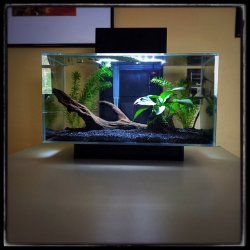thrujenseyes
Fish Herder
Hello,
I'm still new here and unsure if I'm posting in the correct place...
Sorry.
But my anacharis plants are getting "clear" losing color and some leaves are falling off.
I haven't yet started the cycling (fishless) yet as I'm waiting on my heater (should be here within a day or so).
I have amonnia and my master test kit all ready to go though.
I never removed the metal banding on the bottom of the plants as the guy at fish place told me that it helps to keep them rooted. But I've read on line to remove them?!
Should I cut the bottoms and peel some leaves and try to dig into the substrate?!
Should the added amonnia (when I start the cycling) help the plants?
I keep the lights on for about 8 hours a day....should I do more?
The tank is in a large room that fills with sunlight but is not in direct light. So I do use the tank light for about 8 hours at night.
I have one stowaway asassin snail that must have come from the plants and just noticed another teeeeeeeeny one last night.
I have tried to feed the snail some freeze dried shrimp by rooting in the bottom but he (snail) let the shrimp rot?!
Any help would be greatly appreciated and also let me know if I'm posting in the incorrect place.
Thank you!
Jen
I'm still new here and unsure if I'm posting in the correct place...
Sorry.
But my anacharis plants are getting "clear" losing color and some leaves are falling off.
I haven't yet started the cycling (fishless) yet as I'm waiting on my heater (should be here within a day or so).
I have amonnia and my master test kit all ready to go though.
I never removed the metal banding on the bottom of the plants as the guy at fish place told me that it helps to keep them rooted. But I've read on line to remove them?!
Should I cut the bottoms and peel some leaves and try to dig into the substrate?!
Should the added amonnia (when I start the cycling) help the plants?
I keep the lights on for about 8 hours a day....should I do more?
The tank is in a large room that fills with sunlight but is not in direct light. So I do use the tank light for about 8 hours at night.
I have one stowaway asassin snail that must have come from the plants and just noticed another teeeeeeeeny one last night.
I have tried to feed the snail some freeze dried shrimp by rooting in the bottom but he (snail) let the shrimp rot?!
Any help would be greatly appreciated and also let me know if I'm posting in the incorrect place.
Thank you!
Jen


